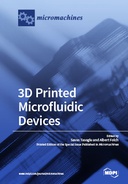Explore

3D Printed Microfluidic Devices
0 Ungluers have
Faved this Work
Login to Fave
3D printing has revolutionized the microfabrication prototyping workflow over the past few years. With the recent improvements in 3D printing technologies, highly complex microfluidic devices can be fabricated via single-step, rapid, and cost-effective protocols as a promising alternative to the time consuming, costly and sophisticated traditional cleanroom fabrication. Microfluidic devices have enabled a wide range of biochemical and clinical applications, such as cancer screening, micro-physiological system engineering, high-throughput drug testing, and point-of-care diagnostics. Using 3D printing fabrication technologies, alteration of the design features is significantly easier than traditional fabrication, enabling agile iterative design and facilitating rapid prototyping. This can make microfluidic technology more accessible to researchers in various fields and accelerates innovation in the field of microfluidics. Accordingly, this Special Issue seeks to showcase research papers, short communications, and review articles that focus on novel methodological developments in 3D printing and its use for various biochemical and biomedical applications.
This book is included in DOAB.
Why read this book? Have your say.
You must be logged in to comment.
Rights Information
Are you the author or publisher of this work? If so, you can claim it as yours by registering as an Unglue.it rights holder.Downloads
This work has been downloaded 238 times via unglue.it ebook links.
- 120 - pdf (CC BY-NC-ND) at Unglue.it.
Keywords
- 3D printing
- Cytotoxicity
- Microfluidics
- Photochemistry
- Polymerization
Links
DOI: 10.3390/books978-3-03897-468-0Editions


